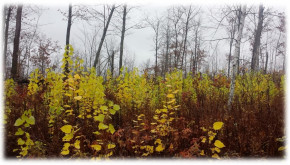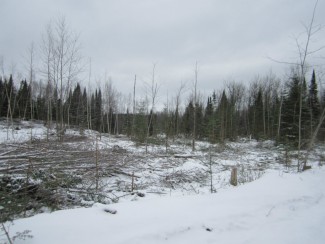
by Nora Kennedy, Private Lands Foresters, American Bird Conservancy
Beauty is in the eye of the beholder, especially when it comes to a regenerating stand of aspen in Northern Wisconsin. To the passerby, a clear-cut might seem like a bomb went off or perhaps even a natural disaster. However, to the trained eye, this is exactly what you want to see. Done properly, a clear-cut or regeneration cut, is meant to mimic a natural disaster to remove the old stand and produce healthy seedlings to replace it. Not only is this great from a forest health standpoint, but this has a huge benefit to wildlife. A regeneration cut will increase the diversity of plant species providing a plethora of food types and brush thickets for cover, especially nice for ground nesting birds and increased edge effects for those species that love to live on the “edge”. An edge is the space where mature forest meets an opening and where many types of birds like to perch and where deer like to run along to dart in between forest trees and the opening. Not all clear-cuts can be considered equal and a few things should be kept in mind including:
Leave reserve trees. A reserve tree is a healthy tree over 9 inches in diameter. 5-10 trees per acre should be left of either deciduous or coniferous trees: it is best that the reserve trees aren’t aspen but different species like oak or pine. Reserve trees contribute to the available seed source, improving the diversity of the stand as well as providing heartier perch trees and cavity trees for wildlife. Snag trees or dead trees can be left, but keep in mind, with the openness of the stand they may be more susceptible to wind and fall over.
Harvest only in the winter under frozen conditions (or dry summer). Keep in mind clear-cuts are
meant to create a disturbance. But, if completed in the winter under frozen conditions, there will be minimal damage to soil, the least amount of disturbance to wildlife than any other time of year and minimal damage to aspen roots resulting in better sprouting come spring. If harvesting in the summer, make sure it’s dry (not an unusually wet year) and that it fall outside the primary bird nesting period of May 1st- August 15th.
Monitor (for the good and bad). In the coming years after the harvest, wildlife will be abundant in the clear-cut area. The increased sunlight will regenerate trees, shrubs and forbs that not only provide a great food source year round, but will also create brushy wildlife cover. You may find that this area will become your new favorite spot for wildlife viewing or hunting. Golden-Winged Warbler, Chestnut sided Warbler, American Woodcock, Ruffed Grouse, Veery, wild turkey and other early-successional species including deer, black bear, and moose benefit from this kind of area. With the addition of more sunlight in the area and new visitors, make sure to also keep an eye out for invasive species. Invasive species, sometimes called noxious species, can easily take advantage of a newly opened area by hitchhiking on new wildlife visitors.
For more information: youngforest.org
For more information on what American Bird Conservancy is doing in the Great Lakes to help the Golden-winged Warbler: abcbirds.org


